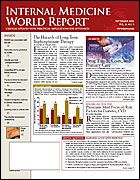Publication
Article
Internal Medicine World Report
The Long-term Mental Health Toll of Chemical Warfare
Results of a new study reveal that exposure to conventional and chemical warfare has severe and enduring adverse effects on mental health, and that exposure to chemical weapons is worse than exposure to conventional weapons (JAMA. 2006;296: 560-565).
This cross-sectional, randomized study, based on a population survey in 3 Iranian towns, was conducted in 2004, 17 years after the Iran—Iraq War. Included were 153 adults (aged ≥18 years; mean age, 45 years) who had been exposed to high- or low-intensity conventional warfare and/or chemical warfare. The 3 towns were Oshnaviyeh (low-intensity conventional warfare), Rabat (high-intensity conventional warfare), and Sardasht (high-intensity and chemical warfare). The participation rate was high—93% for Sardasht and Oshnaviyeh, and 94% for Rabat.
Instruments used to determine full or partial posttraumatic stress disorder (PTSD) and symptoms of anxiety and depression included the Farsi versions of the Beck Depression Inventory, the Hamilton Anxiety Scale, and the Clinician-Administered PTSD Scale.
Among the Sardasht sample, the prevalence of lifetime PTSD, current PTSD, major anxiety symptoms, and severe depressive symptoms was 59%, 33%, 65%, and 41%, respectively. In the Oshnaviyeh sample, the corresponding rates were 8%, 2%, 18%, and 6%, and in the Sardasht sample, they were 31%, 8%, 26%, and 12%.
Compared with individuals exposed to low-intensity conventional warfare, those exposed to both high-intensity conventional and chemical warfare were at significantly greater risk for lifetime PTSD (odds ratio [OR], 18.6), anxiety (OR, 14.6), and depressive symptoms (OR, 7.2). Exposure to high-intensity warfare but not to chemical weapons was also associated with a higher risk of lifetime PTSD (OR, 5.4) compared with exposure to low-intensity conventional warfare. In addition, individuals exposed to both high-intensity conventional and chemical warfare had an increased risk for lifetime PTSD (OR, 3.4), current PTSD (OR, 6.2), anxiety symptoms (OR, 5.6), and depressive symptoms (OR, 3.7) compared with those exposed to high-intensity warfare alone.
“Survivors of chemical warfare need access to medical, psychological, and social resources,” the authors conclude. “Integrated primary and mental healthcare that addresses individual as well as community and family needs is crucial for the effective treatment and promotion of mental health in survivors of chemical warfare.”






